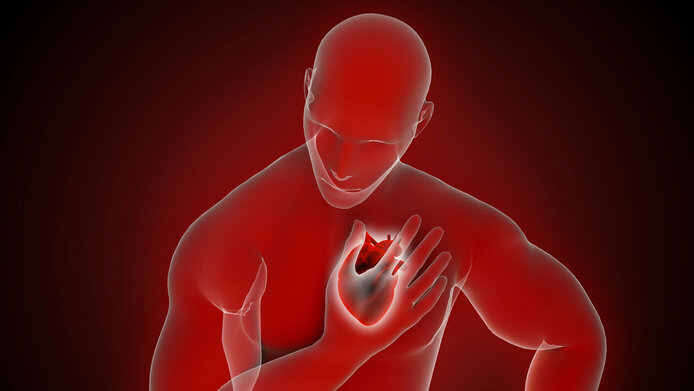Immune system plays cardinal role in heart attacks

A heart attack is a landmark event in many people's lives. Not only will they likely have to change their lifestyle fundamentally, but they may also develop persistent heart failure even in the wake of timely and good treatment. This is caused by extensive scarring of the heart muscle, which reduces the heart’s pumping power. The result: despite a successfully survived emergency and best intentions, the patients may have little chance of ever feeling durably healthy and fit again.
It is difficult to predict whether heart failure will actually develop in an individual case. The trigger for excessive scarring is an excessive inflammatory response of the immune system, and doctors lack both the diagnostic and therapeutic means to prevent such an excessive response in good time. New approaches in this context have now been supplied by medical researchers involved in the EU project “Adaptive immune response in the wounded heart”, which in Austria was funded by the Austrian Science Fund FWF.
In collaboration with colleagues from the University Hospital in Würzburg and the Sorbonne University in Paris, Peter Rainer and his team from the University Heart Center at the Medical University of Graz investigated the complex immunological processes that are involved in the “wound healing” of the heart and are also responsible for scarring. “Our research built on the important insight that the adaptive immune system, which is acquired over the course of one’s life and is different in every individual, plays a key role in the healing process,” notes Rainer. “So it was our goal to find biomarkers or patterns in the individual immunological processes that provide information about the expected course of the ailment.”
The project “Adaptive immune response in the wounded heart” was conducted within the context of the European Research Network ERA-CVD. It received EUR 300,000 in funding from the Austrian Science Fund FWF.
Complex immune dynamics
In most cases, a heart attack is triggered by a blood clot caused by an injury to the walls of blood vessels due to arteriosclerosis – i.e. the “calcification” of the blood vessels. Such an event cuts off the blood and oxygen supply to the heart. Chest pain and shortness of breath occur, and after a few minutes heart cells die. In the worst case, the infarction is followed by cardiac arrest. When the cells die, this also sets off a reaction from the body's own immune system. The process of tissue regeneration that takes weeks after surviving an infarction is extremely dynamic. “The processes at the beginning are very different to those at a later stage,” explains Rainer. “In each phase, the combination of immune and messenger substances is subject to changes. For effective treatment we need a better understanding of these processes.”
The T lymphocytes – which are part of the acquired immune system – become active at the very start of the immune response. As these cells play an important role in the regulation of the inflammatory response, they were of particular interest to Rainer and his colleagues. Their investigations included single-cell sequencing, a method in which the genetic material does not come from a large number of cell nuclei, but can be specifically extracted from an individual cell. “In this way we were able to really break down the work of the immune system to individual cell-level function – and thus to the proteins that the DNA produces in that cell,” Rainer explains. The researchers were particularly interested in which proteins and antigens are recognized by the receptors on the T cells.
Investigations on human tissue
The analysis of different types of human tissue that were available to the project teams offered further insights into the immunological processes. These samples included not only blood, but also specimens of heart muscle from ailing individuals. “Thanks to the availability of these materials, we were able to verify findings from immunological research on animal models with respect to humans,” specifies the physician.
Single-cell sequencing and other methods ultimately helped to gain a deeper understanding of the different healing processes in a small group of selected and very well characterized patients. All participants had just suffered a first “major” heart attack and were thought to have very similar healing prospects. Nevertheless, tissue scarring was better in some than in others.
Insights into the healing process
As Rainer explains, the analysis of the immunological processes at work actually enabled the researchers to find a relevant signature that allows these differences in recovery to be recognized at an early stage. “Our data showed a different immunological footprint in patients with a good healing process than in those with severe scarring,” the researcher emphasizes. “But now these results need to be verified in a more comprehensive study with a larger and more diverse group of heart attack patients.” Future research will have to provide a more detailed understanding of the mechanisms behind the signature found and the associated consequences. Ultimately, however, the approach offers the prospect of a new diagnostic marker that could make timely interventions possible.
Rainer and his colleagues are also using novel approaches in tackling the problem. In a new FWF-funded project, large volumes of patient data – from laboratory findings to X-ray images – are being vetted with the help of artificial intelligence in order to identify correlations with subsequent heart attacks and obtain risk assessments and recommendations for preventive action. And the researchers in the flagship project “VascHealth” at the Medical University of Graz are investigating a kind of feedback effect that occurs in the course of a heart attack. It often leads to a sudden increase in inflammation levels in the body and thus accelerates arteriosclerosis. This initiates a vicious circle that makes further heart attacks more likely. The complex interplay between cardiovascular ailments and the immune system is still fraught with many unanswered questions.
Personal details
Peter P. Rainer studied medicine in Graz and Florence before becoming a postdoctoral fellow at Johns Hopkins University in Baltimore, USA. As of 2018, he worked as an associate professor at the Medical University of Graz and as a senior physician and head of the cardiology outpatient clinics and the heart failure program at the University Heart Center Graz. Rainer is now Head of the Internal Medicine Department at St. Johann District Hospital in Tyrol.
Publications
Delgobo M., Weiß E., Ashour D., Richter L. et al: Myocardial Milieu Favors Local Differentiation of Regulatory T Cells, in: Circulation Research 2023
Sattler S., Ramos GC, Ludewig B., Rainer P: Cardioimmunology: the new frontier!, in: European Heart Journal 2023
Le Gouge K., Ashour D., Heinrichs M., Stys P. et al: A distinct T cell receptor signature associates with cardiac outcome in myocardial infarction patients, in: medRxiv 2023 (pre-print)





